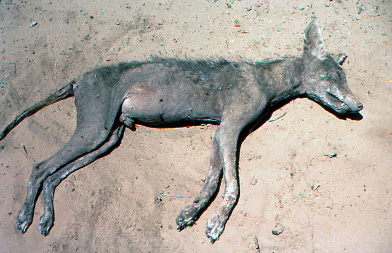GT reader Ramon sent me this interesting article from Discovery News.
The article talks about how wild dogs with mange are the most likely explanation of the feared Chupacabras creature that has been tormenting most major Latin countries.
“Because these animals[wild dogs] are greatly weakened, they’re going to have a hard time hunting,” OConnor said. “So they may be forced into attacking livestock because it’s easier than running down a rabbit or a deer.”
Which makes perfect sense. The only thing that troubles me is the number of eyewitness accounts that state how they’ve observed a creature, green and scaly with red eyes and ‘porcupine-like’ quills on its back. I don’t think it would be fair to say that they all confused a mangy dog with a terrifying creature that looks to be out of a comic book, but sometimes you gotta go with the hard facts.
Can a creature like the Chupacabras really exist?
Full source: Discovery News
Halloween stories about the ghostly “chupacabra” circulate every year, but now scientists have solved the mystery surrounding this legendary animal.
Instead of being vicious, fanged creatures that supposedly drink the blood of livestock, chupacabras turn out to be wild dogs inflicted with a deadly form of mange, according to University of Michigan biologist Barry OConnor.

(Scientists believe legendary chupacabras monsters are actually coyotes with severe cases of mange, like the animal pictured here. Credit: Dan Pence)
The myth about chupacabras, also known as goatsuckers, started after reports of livestock attacks in Puerto Rico and Mexico, where dead sheep were discovered with puncture wounds, completely drained of blood. Similar reports began accumulating from other locations in Latin America and the U.S. Then came sightings of evil-looking animals, variously described as dog-like, rodent-like or reptile-like, with long snouts, large fangs, leathery or scaly greenish-gray skin and a nasty odor. Locals put two and two together and assumed the ugly varmints were responsible for the killings.
OConnor, however, and other scientists conclude that an 8-legged mite that burrows under the skin of coyotes can give these animals the “chupacabra” look.
He explains that the mite responsible for the extreme hair loss seen in “chupacabras syndrome” is Sarcoptes scabiei, which also causes the itchy rash known as scabies in people. Human scabies is an annoyance, but not usually a serious health or appearance problem, partly because our bodies are already virtually hairless and partly because the population of mites on a given person usually is relatively small—only 20 or 30 mites.
Humans have likely evolved natural defenses for this mite over the years. When we began to domesticate dogs, we likely spread the mites to them. When the mites then transfer to wild dogs, such as foxes, wolves and coyotes, the victims appear to be less able to fight them off.
“Whenever you have a new host-parasite association, it’s pretty nasty,” said OConnor, a professor of ecology and evolutionary biology and a curator in the U-M Museum of Zoology. “It does a lot of damage, and mortality can be relatively high because that host species has not had any evolutionary history with the parasite, so it has not been able to evolve any defenses like we have.”
In these unfortunate animals, large numbers of mites burrowing under the skin cause inflammation, which results in thickening of the skin. Blood supply to hair follicles is cut off, so the fur falls out. In especially bad cases, the animal’s weakened condition opens the door to bacteria that cause secondary skin infections, sometimes producing a foul odor. Put it all together, and you’ve got an ugly, naked, leathery, smelly monstrosity: the chupacabras.
But what then explains the “goatsucker” livestock attacks?
“Because these animals are greatly weakened, they’re going to have a hard time hunting,” OConnor said. “So they may be forced into attacking livestock because it’s easier than running down a rabbit or a deer.”
Wild dogs aren’t the only ones to suffer from deadly mites. Mite-infected squirrels often become roadkill because they are weak and less able to scurry away from cars. In Australia, the “chupacabra” mite is killing off wombats.
“(Wombats) presumably got the mites from dingoes, which got them from domestic dogs, which got them from us,” he explained.
4 comments



